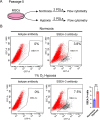Hypoxia boosts pluripotent-like muse cell ratio in mesenchymal stromal cells and upregulates the pluripotency gene expression
- PMID: 40854920
- PMCID: PMC12378945
- DOI: 10.1038/s41598-025-03806-x
Hypoxia boosts pluripotent-like muse cell ratio in mesenchymal stromal cells and upregulates the pluripotency gene expression
Abstract
Muse cells are SSEA-3-positive pluripotent-like endogenous stem cells found in various tissues, including peripheral blood and organ connective tissue. Their reserve is considered the hypoxic bone marrow. In mesenchymal stromal cell (MSC) cultures, Muse cells comprise several percent of the population. Clinical trials using intravenous administration of Muse cells without genetic modification or differentiation induction have shown significant therapeutic potential. Since Muse cells are a small fraction of MSCs, developing efficient culture methods to increase their proportion while maintaining their stemness is crucial for enhancing efficiency and reducing costs in clinical research. In this study, we investigated the effects of hypoxia on Muse cell proportions, pluripotency gene expression, and metabolism. Hypoxia increased the Muse cell proportion around twofold, driven by HIF2α rather than HIF1α, and enhanced pluripotency gene expression, potentially via microRNA let-7 upregulation. Hypoxia also shifted metabolism from oxidative phosphorylation to glycolysis, linked to maintaining stem cell properties. These findings suggest that hypoxia represents a cost-effective strategy for expanding Muse cells, offering promising potential for clinical applications.
Keywords: Hypoxia; Hypoxia-inducible factor; Mesenchymal stromal cells; Muse cells; Pluripotency genes.
© 2025. The Author(s).
Conflict of interest statement
Declarations. Competing interests: The authors declare no competing interests.
Figures





Similar articles
-
Comparison of MSCs and Muse cells: the possible use for healthspan optimization.Biogerontology. 2025 Jul 2;26(4):139. doi: 10.1007/s10522-025-10275-2. Biogerontology. 2025. PMID: 40601066 Free PMC article.
-
Isolation of SSEA-3-positive mesenchymal stem cells from equine bone marrow and evaluation of their pluripotency.Res Vet Sci. 2025 Sep;193:105736. doi: 10.1016/j.rvsc.2025.105736. Epub 2025 Jun 3. Res Vet Sci. 2025. PMID: 40483973
-
Hypoxic mesenchymal stem cell-derived exosomes promote bone fracture healing by the transfer of miR-126.Acta Biomater. 2020 Feb;103:196-212. doi: 10.1016/j.actbio.2019.12.020. Epub 2019 Dec 17. Acta Biomater. 2020. PMID: 31857259
-
Multipotent/pluripotent stem cell populations in stromal tissues and peripheral blood: exploring diversity, potential, and therapeutic applications.Stem Cell Res Ther. 2024 May 12;15(1):139. doi: 10.1186/s13287-024-03752-x. Stem Cell Res Ther. 2024. PMID: 38735988 Free PMC article. Review.
-
Unravelling the pluripotency paradox in fetal and placental mesenchymal stem cells: Oct-4 expression and the case of The Emperor's New Clothes.Stem Cell Rev Rep. 2013 Aug;9(4):408-21. doi: 10.1007/s12015-011-9336-5. Stem Cell Rev Rep. 2013. PMID: 22161644
References
-
- Ogura, F. et al. Human adipose tissue possesses a unique population of pluripotent stem cells with nontumorigenic and low telomerase activities: potential implications in regenerative medicine. Stem Cells Dev.23, 717–728. 10.1089/scd.2013.0473 (2014). - PubMed
-
- Hori, E. et al. Mobilization of pluripotent Multilineage-Differentiating Stress-Enduring cells in ischemic stroke. J. Stroke Cerebrovasc. Dis.25, 1473–1481. 10.1016/j.jstrokecerebrovasdis.2015.12.033 (2016). - PubMed
MeSH terms
Substances
LinkOut - more resources
Full Text Sources

